Bulletin E368
Hazelnuts are increasing in popularity worldwide for their use in many products including various confections, nut butters, and baked goods. Current commercial production relies primarily on cultivars of the European species, Corylus avellana, and is centered in regions with Mediterranean-like climates. Today, more than 65% of the world’s crop is produced along the Black Sea in Turkey, followed by around 15% in Italy and less than 5% in the United States. Other countries contributing to the total include the Republic of Georgia, Azerbaijan, Chile, France, Spain, and China. In the United States, 99% of hazelnuts are grown in the Willamette Valley of Oregon, an area with a moderated climate and a history of production that dates back over 100 years.
Hazelnuts are sold in two different markets, the blanched kernel and the in-shell market, and the cultivars grown for each are different. The blanched kernel market represents about 93% of the world’s crop, with most kernels being used by the confectionary industry. In the past, the disease eastern filbert blight has prevented hazelnut production in eastern North America. However, with recent breeding advances it is now possible to grow cultivars of European hazelnut in places they were not grown widely before, including New Jersey, Pennsylvania, New York, and other states in the Mid-Atlantic region. Several wild hazelnut species including C. americana from North America and C. heterophylla from Asia have also been used in breeding to expand the range of production further. Thus, many new cultivars have become available, which creates a need to evaluate them for production characteristics under local conditions.
The objective of this bulletin is to help growers choose hazelnut plants for orchards in New Jersey. It provides background on worldwide hazelnut production, hazelnut flowering biology, eastern filbert blight disease, and propagation methods. It also describes cultivars and provides a list of nurseries that offer plants for sale.
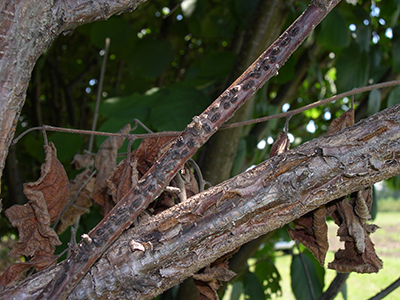
Figure 1: Eastern Filbert Blight canker on hazelnut stem. Photo Credit Tom Molnar.
Eastern Filbert Blight and the Commercial U.S. Hazelnut Industry
Nearly all European hazelnut cultivars are highly susceptible to a stem canker disease called eastern filbert blight (EFB), which has largely prevented hazelnut production in the eastern U.S. (Figure 1). The disease is caused by the obligate fungus Anisogramma anomala, which is harbored by the wild American hazelnut, Corylus americana (Muehlbauer et al., 2019). While C. americana rarely displays serious symptoms of the disease, it acts as a source of inoculum, perennially spreading spores of the fungus over its wide native range that spans much of the eastern U.S. and southern Canada. Consequently, when a susceptible European hazelnut is planted in this region, it inevitably becomes infected by A. anomala and eventually dies from EFB.
Furthermore, while historically absent west of the Rocky Mountains, EFB was inadvertently spread to Washington State around 1960, and then to Oregon where it now adds considerable management costs to hazelnut production in the Willamette Valley (Johnson & Pinkerton, 2002). Complete orchard loss to disease was not uncommon. However, the recent development of EFB-resistant cultivars by Oregon State University (OSU) has supported a great expansion of production in that region, and acreage has more than doubled over the past 10 years (over 79,000 acres in 2020). Unfortunately, research at Rutgers University has shown that the new cultivars selected in Oregon are susceptible to EFB in New Jersey and other regions where a greater diversity of the fungus is present (Molnar et al., 2010a, 2010b; Capik and Molnar, 2012; Muehlbauer et al., 2018, 2019), which may limit their use outside of the Pacific Northwest. However, research and breeding success at Oregon State University has paved the way for breeding for resistance in other regions.
The Rutgers University hazelnut research and breeding program was started in 1996. An early goal of the program was to collect plant material from across hazelnut growing regions of the world to identify new sources of resistance to EFB. The new sources were then used to breed improved cultivars adapted to New Jersey (Capik et al., 2013; Molnar et al., 2005, 2007, 2018). This process has been ongoing for more than two decades and in close collaboration with Oregon State University. The first EFB-resistant cultivars from the Rutgers program were released in 2020 and are described in this document. Multiple sources of resistance are being used in the breeding program help manage disease in the long term. Other available EFB-resistant cultivars and seed-propagated hybrids are also discussed.
Details on eastern filbert blight disease, its management, and cultivar response to disease in Oregon can be found in the following resources:
Hazelnut Floral Biology
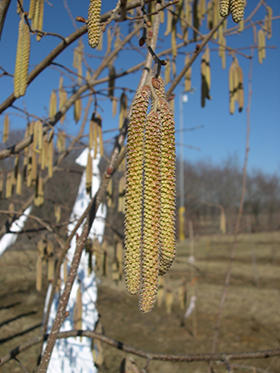
Figure 2: Male hazelnut flower (catkin, staminate flower). Photo Credit Tom Molnar.
Hazelnuts are monecious (separate male and female flowers on the same plant) and wind pollinated. They are also self-incompatible, meaning the pollen from one plant cannot fertilize the female flowers on that same plant, including its own clones. Incompatibility is of the sporophytic type and controlled by S-alleles (also called incompatibility alleles) expressed in the pollen and the female flowers. The S-allele(s) expressed in the pollen of one tree must be different from the S-alleles expressed by the female flowers of the other tree to produce nuts. Thus, at least two hazelnut trees with different S-alleles are required for nut production. Pollen must also be released at the proper time for overlap with female flower bloom. Further details on hazelnut bloom in New Jersey can be found in Capik and Molnar (2014). See the OSU guide detailing pollination and nut development and Germain (1994) for additional information.
Male Flowers
The male flowers, called catkins or staminate flowers, are the pollen producing structures (Figure 2). They begin to visibly develop in July in preparation for pollen shed early the following year. The catkins break dormancy during the winter and elongate to more than double their size. They then release their pollen, which is spread via wind. Pollen shed generally occurs in February through March in New Jersey. However, the specific dates each year depend on the cultivar, weather (especially temperature), and location. Plants can be classified as early, mid-, and late-blooming; and orchard design must take this into consideration for successful overlap of pollen shed and female bloom.
Female Flowers

Figure 3: Female hazelnut flower (floret, pistillate flower). Photo Credit Tom Molnar.
The female flowers (pistillate flowers) consist of a tuft of tiny, inconspicuous, dark pink stigmas extruding from a vegetative bud (Figure 3). The stigmas emerge and are receptive to pollen during winter (typically late December through March). The timing of emergence of female flowers, pollination, and fertilization all depend on annual climate, location, and cultivar. Like catkin blooms, plants can be generally classified as early, mid-, and late-blooming and orchard design should take this into consideration. In New Jersey, most plants are protogynous, meaning the female flowers tend to emerge before the catkins shed pollen on the same plant. Interestingly, in warmer, Mediterranean-like climates (e.g., Oregon and Italy), the same cultivars tend to be protandrous (pollen bloom occurs before female flower emergence). Hazelnut pistillate flowers are also botanically unique as they remain receptive to pollen for multiple weeks after emergence and have been found to be very cold hardy (most surviving lower than -20 °F).
Pollination
It is important to note that adequate, compatible pollination is a prerequisite for good hazelnut crops. In some years, this can be challenging in New Jersey due to rapid fluctuations in winter temperature where prolonged warm spells can cause catkins to break dormancy too early and become susceptible to frost damage during subsequent cold weather. Damage is exacerbated by drying out during high winds. Female flowers may also emerge early but are cold hardy and stay receptive for multiple weeks waiting for pollen, and thus present fewer challenges. Pollination also requires proper timing (phenology) of bloom, where the pollinizer cultivars must shed pollen when the nut producing cultivar’s female flowers are receptive (and not before). Therefore, a diverse mix of different compatible hazelnut plants in the orchard including early, mid, and late pollen shedding types with compatible S-alleles is highly recommended as a buffer to minimize issues with pollination and timing of bloom. The planting of cold hardy hybrid hazelnut seedlings in border rows, as discussed in more detail subsequently, is also recommended to help diversify the S-alleles present and widen the pollen shedding window to ensure adequate pollination of clonal cultivars each year.
Sourcing Hazelnut Plants
Hazelnuts are a new crop to most growers in the New Jersey and the Mid-Atlantic region. A variety of hazelnut plants have become available, which include seed-propagated plants as well as those produced through asexual (clonal) propagation. Prior to purchasing hazelnut plants and investing in establishing a hazelnut orchard, it is critical to understand the plant material under consideration. This includes knowledge of species, cultivars, hybrids, and their methods of propagation.
Basic Vocabulary
Propagation
The art and science of multiplying plants while preserving their unique properties.
Sexual/Seed Propagation
Hazelnut trees derived from the germination of seeds. In self-incompatible plants like hazelnuts (not self-pollinating, highly heterozygous), this leads to significant variation in the resulting offspring.
Nurseries that sell “seedling” hazelnut trees have typically germinated and grown open-pollinated seeds from a select group of plants for sale (for example, a local population of native C. americana to be used in wildlife plantings or a group of inter-pollinating cultivars). “Hybrid hazelnuts” grown in the Upper Midwest and other northern regions are generally plants germinated from seed originating from the open pollination of select plants derived from the earlier crosses of native C. americana with European hazelnuts. Seed-grown hazelnuts are generally too variable to support commercial nut production as they lack consistent yields, kernel quality, and disease resistance but can be used as pollinizers, rootstocks, backyard trees, and in plantings for wildlife and conservation, etc.
Note that hazelnut breeding programs also rely on seed propagation for the development of new cultivars. However, in breeding programs large populations of seedling plants are grown from controlled crosses of known parents. Elite individuals are then identified through a rigorous, multi-year selection process and clonally propagated for further testing and eventual release.
Asexual Propagation/Clonal Propagation
The multiplication of a plant by cloning, where an exact duplicate of a single genotype is made. To retain a hazelnut cultivar, it must be propagated asexually (like apple trees, for example). In theory, clones of plants can be generated from stem, root, and leaf pieces through various methods, with stem/shoot tissue used in most processes. Asexual propagation methods relevant to hazelnuts are described below. Note that commercial production of the vast majority of tree fruit and nut crops is based on clonally propagated cultivars.
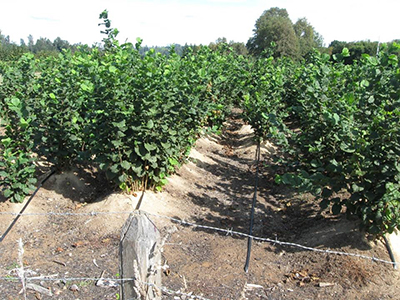
Figure 4: Propagation of hazelnut cultivars by stool bed layers. Photo Credit Tom Molnar.
Methods of Clonal Propagation
Layering: A method of clonal propagation where young shoots (suckers) or branches are covered in a moist growing medium outdoors until they develop roots while still attached to the mother plant (Figure 4). Hazelnuts were historically propagated through simple layering, but stool bed (mound) layering is now mostly used in its place. These processes both follow the same principles, and the cultivar grows on its own roots, unlike grafting. Typically, rooting hormones like indole butyric acid (IBA) are sprayed on the shoots when the process is initiated. A hog ring staple or plastic zip tie is often fastened tightly to the base of the shoot to girdle the shoot as it grows and further enhance rooting. In the fall, after roots are formed and leaves have dropped, the new “layer” is cut below the roots, effectively multiplying the cultivar. Layering remains one of the most widely used forms of hazelnut clonal propagation worldwide.
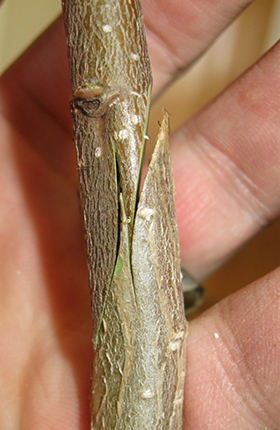
Figures 5: The uncalloused graft union (whip and tongue graft) of a hazelnut scion and rootstock. Photo Credit Tom Molnar.
Grafting: A process of joining two pieces of plant tissue (Figure 5) in such a way that they will unite and form one composite plant. The scion is the upper portion of the graft (the cultivar of interest); and the rootstock serves as the root system for the plant (often imparting characteristics such as disease or drought resistance, or dwarfing). Hazelnuts can be grafted but are not commonly available in this form due to the challenges associated with suckering from the crown of the plant and the lack of dedicated EFB-resistant rootstocks. On occasion in the U.S. and more so in Europe, the Turkish tree hazel, C. colurna, has been used as a rootstock due to its single trunk growth habit that reduces the need to manage suckers in the orchard. The species is also reported to be more drought tolerant. The C. colurna x C. avellana hybrids, ‘Newberg’ and ‘Dundee’, were developed by the USDA in Oregon as non-suckering rootstocks. Unfortunately, their susceptibility to EFB greatly limits their use in the U.S.
Rooted cuttings: A process where cuttings of a plant stem are placed under favorable conditions (bottom-heat, high humidity, etc.) with rooting hormones like IBA applied to the basal portion of the stem piece to induce root formation. This method is generally inconsistent for hazelnut propagation. Results from dormant stem cuttings tend to be highly variable from plant to plant and year to year. Softwood cuttings usually root well but the apical bud tends to die resulting in a plant with no growing point. The process showing most regular success to date includes using softwood cuttings of young suckers from the crown of the plant, especially from greenhouse-grown plants recently derived from tissue culture.
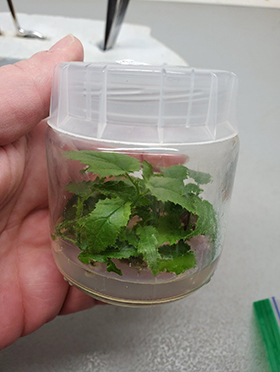
Figure 6: Hazelnuts in tissue culture (micropropagation). Photo Credit Elizabeth Dunham, Knight Hollow Nursery.
Tissue culture (micropropagation): A method of propagation where plants are grown from cuttings (leaf, stem, or root pieces) in sterile laboratory environments (Figure 6). Shoot tips (growing tips including the apical meristem) are generally used as the starting material for hazelnut. A careful combination of plant hormones, nutrients, and a gelling agent serve as a growing medium to promote efficient and exponential multiplication of clean (virus/pathogen free) plant material. The shoot (stem) portions of hazelnut plants are typically initiated and then exponentially multiplied in sterile culture dishes. After multiplication, the new stems are excised from culture and rooted as tiny stem cuttings under high humidity greenhouse conditions. Tissue culture propagation of hazelnuts has become much more widely used in the U.S. and worldwide and is especially useful for ramping up numbers of new cultivars in a quick and efficient manner compared to other available propagation processes.
Hazelnut Species
The Corylus genus consists of 13 polymorphic species native to the temperate zones of the northern hemisphere, with its center of diversity in Asia. They range from small to large, multi-stemmed shrubs to stately, single trunk trees. See Molnar (2011) (Wild Crop Relatives: Genomic and Breeding Resources | SpringerLink) for more detailed taxonomic and botanical descriptions across the genus. Corylus avellana, the European hazelnut, is the primary commercial species around the world, although all species produce edible nuts; and most were harvested from wild stands in the past as a source of food. Collection of wild C. heterophylla continues today in China. Since the climate is amenable and the nut quality is by far the best of the genus, EFB-resistant cultivars of the European hazelnut are the main recommended species for growers in New Jersey and parts of the Mid-Atlantic region. These would be supplemented with interspecific American x European hybrids as pollinizers and for nut production where applicable. More information on these species and hybrids is provided below.
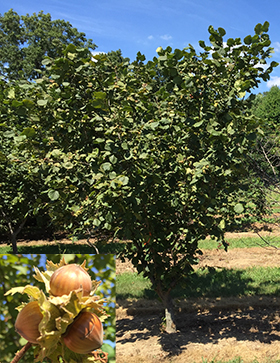
Figure 7: Corylus avellana tree pruned to a single stem, and a mature nut in the husk. Photo Credit: Tom Molnar.
Corylus avellana
The European hazelnut, native to a wide area of Europe from coastal Norway to north of Moscow to the Caucasus Mountains stretching into northwestern Iran, is the main species utilized for commercial hazelnut production worldwide (Figure 7). Cultivars have been selected for either the in-shell fresh market (large to jumbo size nuts with sweet kernels and attractive shells) or the blanched kernel market (small to medium size nuts with round kernels and good roasting qualities). Premier kernel cultivars, such as the Italian 'Tonda Gentile delle Langhe' preferred by confectionery manufacturers, are noted for having round 11-13 mm size kernels (around 1.0 to 1.2 grams) with thin shells (46–50% kernel to shell by weight), excellent flavor, and good pellicle (kernel skin) removal once roasted. Cultivars grown in the U.S., Italy, Spain, etc. release the nuts from the husk at maturity to allow easy machine harvest from the orchard floor. In contrast, cultivars grown in Turkey, where the orchards are on very steep slopes, hold the nuts in long clasping husks that facilitate hand harvest from trees. Plants can be adapted to USDA Hardiness Zones 5–8, depending on the cultivar. While vegetative parts and female flowers of most European hazelnut plants are cold hardy in the Mid-Atlantic region, catkins can be at risk to cold damage during temperature fluctuations in the late winter. Most standard cultivars grown around the world are very susceptible to EFB, which has made it impossible to grow them in the eastern U.S.; however, EFB-resistant/tolerant plants are now available.
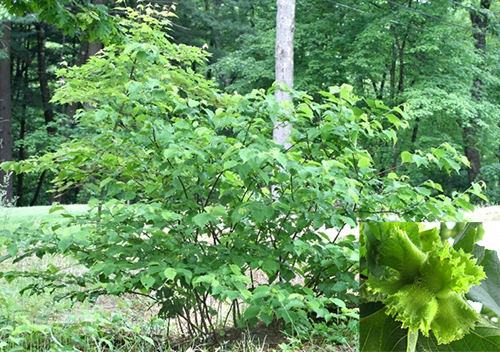
Figure 8: Corylus americana shrub, and an immature nut in the husk. Photo Credit: Tom Molnar.
Corylus americana
The wild American hazelnut, native to the eastern U.S. and southern Canada, is a small shrub generally found growing along forest edges, clearings, and roadsides across a variety of climates and soils. It is characterized by having much smaller nuts (0.4 to 0.6 gram kernels) held in thick fleshy husks (Figure 8), with thicker shells (~35% kernel) than European hazelnuts. While it has edible kernels, its very shrubby growth habit and small nuts make it unsuitable for standard commercial nut production. However, in general the plants are EFB resistant and its catkins are more cold hardy than European hazelnut, which makes them nice backyard garden and conservation plants and a valuable breeding partner with the European hazelnut to develop interspecific hybrids with wider adaptation (see section below). Very few clonal C. americana cultivars have been selected, although some, like ‘Rush’ from Pennsylvania and ‘Winkler’ from Iowa, were at one time available from nurseries. Some forms of C. americana have attractive red, orange, pink, and yellow fall color with showy husks that add to their landscape appeal. Plants can be adapted to USDA Hardiness Zones 3–8, depending on the seed source.
Hybrid Hazelnuts
Interspecific hybrids, called “hybrid hazelnuts”, in North America are generally derived from crosses between C. americana and C. avellana although other species combinations are possible. The objective is generally to combine the nut quality and yields of the European hazelnut with the adaptation and disease resistance of the wild species. Breeding efforts in the early 1900s led to the development of the F1 hybrids of C. americana 'Rush' x C. avellana, some of which are still available today including clones of NY 616 sold under the name ‘Slate’ and NY 398 sold under the name ‘Gene’ (or ‘Geneva’) (Molnar, 2011). While the NY selections are clonally propagated, most hybrid hazelnuts currently available and planted by growers in recent years are from germinated seed. They are typically derived from openly intercrossing various hybrid plants over multiple generations. Many plants from Upper Midwest sources trace their origins to C. americana ‘Winkler’ and local selections in Wisconsin and the breeding work of Carl Weschcke in the 1940s-60s. This work was continued more recently by Phil Rutter and others in Minnesota (Weschcke, 1954; Rutter, 1987; Molnar, 2011). These seed-propagated hybrids are highly variable in many traits, which tend to result in low average yields per acre along with the production of small, thick shelled nuts. Fortunately, improved individuals do exist in these populations. Several programs, including the Hybrid Hazelnut Consortium, Upper Midwest Hazelnut Development Initiative, and some private nurseries (see Table 2), are now in the process of developing, identifying, and propagating improved clones of cold hardy hybrid hazelnuts. These clonal hybrids hold significant potential for commercial hazelnut production in northern regions. As an example, nearly all of China’s current orchard plantings are based on cold hardy clonal cultivars of C. heterophylla x C. avellana origin called the Ping’ou hybrids (note that they also harvest wild C. heterophylla from local forests). These plants are grown in a region too cold for pure European hazelnut. When considering the moderate climate of New Jersey and the Mid-Atlantic region, hybrid hazelnuts generally have improved hardiness of catkins and later catkin bloom dates than selections of the European species, but their smaller kernels and thicker shells are inferior. They are suggested here as supplemental pollinizers for European cultivars to diversify S-alleles and provide consistent pollen production across yearly climatic fluctuations. Clonal hybrid plant material should also be considered for main crop cultivars in regions too cold for European hazelnut.
Hazelnut Cultivars Around the World
In the world’s traditional regions of hazelnut cultivation, in particular Turkey, Italy, and Spain, production still relies on historical (ancient) cultivars that were selected from local, wild vegetation. The major Turkish cultivars are Tombul, Palaz, and Foşa. The primary Italian cultivars are Tonda Gentile delle Langhe, Tonda Romana, Tonda di Giffoni, Mortarella, and San Giovanni. Negret is the main cultivar of Spain. The origins of these important cultivars are largely unknown (lost with antiquity), but their predominance was solidified when the confectionary industry set quality standards for processing kernels in the mid to late twentieth century. Modern breeding programs began in Italy, France, and the U.S. in the 1960s with a focus on improving kernel quality and yield. Additional programs were also started in Romania, Turkey, and China. However, except in the U.S. where breeding has continued (and expanded), programs in much of the rest of the world have been discontinued or significantly reduced in scale. Most production outside of the U.S., France, and China, including new plantings, still relies on a small group of traditional cultivars (Botta et al., 2019). Note that EFB remains confined to North America, which allows the rest of the world to continue using traditional cultivars, nearly all of which are highly susceptible to the disease. In the past, EFB-susceptible ‘Barcelona’, a cultivar from Spain grown for the in-shell market, was the most widely planted cultivar in the Willamette Valley of Oregon. Today, its use has been supplanted by the new EFB-resistant cultivars from Oregon State University (Table 1).
| Cultivar | Market Type | Notable Characteristics | S-alleles1 | Reference |
|---|---|---|---|---|
| Willamette2 | Kernel and in-shell | Tolerant to EFB in OR, susceptible in NJ. Round kernels around 1.50 grams with 50%3 kernel to shell by weight. Very good blanching. Nuts mature a week later than ‘Barcelona’. | S1S3 | Mehlenbacher, Miller, Thompson, Lagerstedt, & Smith, 1991 |
| Lewis2 | Kernel | Offspring of ‘Willamette’. Tolerant to EFB in OR, susceptible in NJ. Round kernels around 1.40 grams with 47% kernel to shell by weight. Moderate to good blanching. Nuts mature 5 days before ‘Barcelona’. | S3S8 | Mehlenbacher, Azarenko, Smith, & McCluskey, 2000 |
| Clark2 | Kernel | Offspring of ‘Willamette’. Moderate tolerance to EFB in OR. Round kernels around 1.25 grams with 51% kernel to shell by weight. Very good blanching. Nuts mature 8 days before ‘Barcelona’. | S3S8 | Mehlenbacher, Azarenko, Smith, & McCluskey, 2001 |
| Sacajawea | Kernel and in-shell | High level of tolerance to EFB in OR, moderate tolerance in NJ (quantitative resistance). Round kernels around 1.45 grams with 52% kernel to shell by weight. Very good blanching. Nuts mature 10–14 days before ‘Barcelona’. Notable for its excellent kernel quality and flavor. Parent of ‘Monmouth’ and ‘Hunterdon’. | S1S22 | Mehlenbacher, Smith, & McCluskey, 2008 |
| Yamhill | Kernel | EFB resistant in OR (‘Gasaway’ resistance4), but susceptible in NJ. Round kernels around 1.12 grams with 49% kernel to shell by weight. Moderate to good blanching. Nuts mature 10–14 days before ‘Barcelona’. Notable for high yields and compact tree form. | S8S26 | Mehlenbacher, Smith, & McCluskey, 2009 |
| Jefferson | In-shell | EFB resistant in OR (‘Gasaway’ resistance), but susceptible in NJ. Round kernels around 1.66 grams with 45% kernel to shell by weight. Moderate to good blanching. Nuts mature along with ‘Barcelona’. Widely planted in OR. | S1S3 | Mehlenbacher, Smith, & McCluskey, 2011 |
| Dorris | Kernel and in-shell | EFB resistant in OR (‘Gasaway’ resistance), but susceptible in NJ. Round kernels around 1.50 grams with to shell 43% kernel to shell by weight. Very good blanching. Nuts mature along with ‘Barcelona’. | S1S12 | Mehlenbacher, Smith, & McCluskey, 2013 |
| Wepster | Kernel | EFB resistant in OR (‘Gasaway’ resistance), but susceptible in NJ. Round kernels around 1.11 grams with to shell 47% kernel to shell by weight. Very good blanching. Nuts mature 7 days before ‘Barcelona’. Notable for high yields and quality. | S1S2 | Mehlenbacher, Smith, & McCluskey, 2014 |
| McDonald | Kernel | EFB resistant in OR (‘Gasaway’ resistance), but susceptible in NJ. Round kernels around 1.21 grams with 51% kernel to shell by weight. Very good blanching. Nuts mature 14 days before Barcelona. Notable for high yields and quality. | S2S15 | Mehlenbacher, Smith, & McCluskey, 2016 |
| PollyO | Kernel | EFB resistant in OR (‘Gasaway’ resistance), untested in NJ. Round kernels around 1.38 grams with 48% kernel to shell by weight. Very good blanching. Nuts mature 10–14 days before ‘Barcelona’. Notable for high yields and quality. | S2S10 | Mehlenbacher, Smith, & McCluskey, 2019 |
1The underlined number is the self-incompatibility (S-allele) expressed in the pollen. Co-dominance exists for some S-alleles and in these cases both numbers are underlined. Both alleles are expressed in the stigmas.
2These cultivars are now considered obsolete in Oregon. They have been replaced by newer cultivars expressing a higher level of resistance to EFB and are no longer widely available from nurseries. They are included as a point of reference as trees of the cultivars are still in production.
3Kernel percentage is calculated by weighing ten typical (non-defective) nuts and kernels and using this formula: (10 kernel weight/10 nut weight) x 100. 'Barcelona', the previous Oregon in-shell standard, has thick shells and a low kernel percentage (43–44%). A larger kernel percentage is more desirable, such as 48% for Italian 'Tonda Romana' and 51% for McDonald. Since nuts are sold in-shell by weight, the higher percentage is desired as buyers of nuts do not want to pay for the shells.
4Despite showing very high tolerance and/or resistance to EFB in the Pacific Northwest, all cultivars listed that are protected by the ‘Gasaway’ resistance gene (with the exception of PollyO, which has not yet been tested at Rutgers) have been shown to get EFB under the high disease pressure and local Anisogramma anomala populations in New Jersey. Research has shown that the trees can die from the disease within a few years after exposure (Capik and Molnar, 2012; Molnar, unpublished). Note that the A. anomala populations found in New Jersey have significantly more genetic diversity than that observed in Oregon (Dunlevy et al., 2019; Tobia et al., 2017). While the ‘Gasaway’-protected cultivars are adapted to New Jersey’s climate and in general produce excellent quality nuts, because of disease severity and risk of tree death they are not recommended for commercial planting in the Mid-Atlantic region. Chemical fungicide programs have been developed for growing susceptible ‘Barcelona’ in Oregon (See Pacific Northwest Disease Management Handbook). This may be helpful, however, they require multiple applications each year, are not 100% effective in Oregon, and have not been proven in New Jersey, which is believed to have a longer period of disease spread due to a much wetter summer climate than Oregon that facilitates continued infection.
Hazelnut Cultivars for the Eastern United States: Recommendations for Orchards in New Jersey
The list below includes new cultivars developed at Rutgers University in collaboration with Oregon State University. They were selected for high yields and very good nut quality in New Jersey, combined with resistance or very high levels of tolerance to EFB. Also included in the list are three additional cultivars available from nurseries that were identified through tests at Rutgers University as compatible, EFB-resistant pollinizers that also produce good to very good yields of nuts. The data presented are from trees grown at Rutgers University. Note that climatic and soil conditions, disease pressure, soil fertility, and other aspects of orchard management play a role in traits like kernel quality, overall yield, and tree growth.
In addition to suggested clonal pollinizers, a diverse collection of hybrid hazelnut seedlings is recommended to be planted in border rows and within plots larger than one acre to produce a consistent pollen cloud for the clonal cultivars (which can have more frost sensitive catkins). At a 18–20' spacing between rows, every 6th row is recommended to be a pollinizer seedling row.
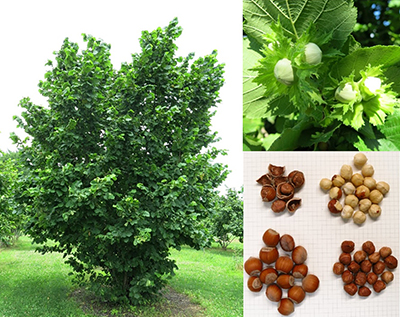
Figure 9: Rutgers University hazelnut cultivar ‘Raritan’. Photo Credit: Tom Molnar.
Raritan
A cross of Oregon State University selections OSU 539.031 x OSU 616.018, it is high yielding with medium size, round kernels that blanch well after roasting, making it well suited for the kernel market (Figure 9). Most kernels are 12–14 mm in diameter with an average weight of 1.14 grams and 48% kernel by weight. ‘Raritan’ is a very vigorous tree with an upright growth habit and a very high level of tolerance to EFB (quantitative resistance). It has S-alleles 3 and 22 with S3 expressed in the pollen, and blooms in early to mid-season in New Jersey. ‘Monmouth’ (S1S12), ‘OSU 541.147’ (S8 S23), ‘Slate’ (NY616) (S1S23), ‘Gene’ (NY398) (S15S23), and ‘Grand Traverse’ (S11S25) are compatible pollinizer partners. Nuts typically drop the first to second week in September.
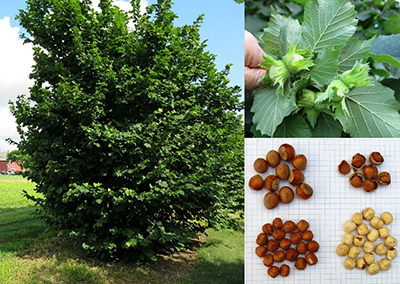
Figure 10: Rutgers University hazelnut cultivar ‘Monmouth’. Photo Credit: Tom Molnar.
Monmouth
A cross of ‘Sacajawea’ x Oregon State University selection OSU 616.055, it is a high yielding tree with medium size, round kernels that blanch very well after roasting, making it well suited for the kernel market (Figure 10). Most kernels are 12–14 mm in diameter with an average weight of 1.19 grams and 52% kernel by weight. ‘Monmouth’ is a moderately vigorous tree with a slightly spreading growth habit and a very high level of tolerance to EFB (quantitative resistance). It has S-alleles 1 and 12 with both expressed in the pollen, and blooms in the early part of the season in New Jersey. ‘Raritan’ (S3S22), ‘Somerset’ (S3S10), ‘OSU 541.147’ (S8 S23), ‘Gene’ (NY398) (S15S23), and ‘Grand Traverse (S11S25) are compatible pollinizer partners. Nuts typically drop the first to second week in September.
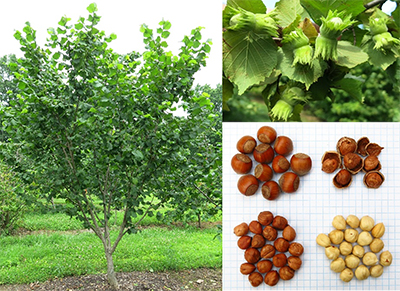
Figure 11: Rutgers University hazelnut cultivar ‘Hunterdon’. Photo Credit: Tom Molnar.
Hunterdon
A cross of ‘Sacajawea’ x Oregon State University selection OSU 616.055, it is a high yielding tree with mostly round, medium to large size kernels (some slightly oblong [<25% of the kernels]) that blanch exceptionally well after roasting, making it best suited for the kernel market (Figure 11). Most kernels are 12–14 mm in diameter with an average weight of 1.23 grams and 46% kernel by weight. In addition to excellent blanching, its kernels are noted for outstanding flavor. ‘Hunterdon’ is a vigorous, upright tree with a slightly spreading growth habit and a high level of tolerance to EFB, though slightly less than ‘Raritan’ and ‘Monmouth’ (quantitative resistance). It has S-alleles 1 and 3 with 3 expressed in the pollen, and blooms in early to mid-season in New Jersey. ‘OSU 541.147’ (S8S23), ‘Gene’ (NY398) (S15S23), and ‘Grand Traverse (S11S25) are compatible pollinizer partners. Nuts typically drop from the end of August to first week in September.
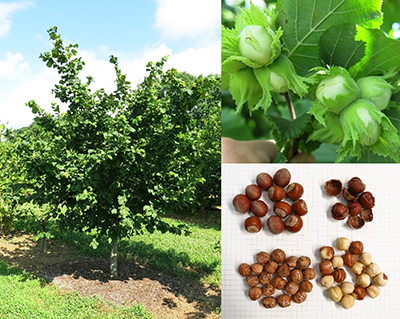
Figure 12: Rutgers University hazelnut cultivar ‘Somerset’. Photo Credit: Tom Molnar.
Somerset
A cross of Oregon State University selection OSU 665.123 x ‘Ratoli’, it is a high yielding tree with small to medium size, round kernels with adequate blanching after roasting, making it well suited for the kernel market (Figure 12). Most kernels are 12–13 mm in diameter with an average weight of 1.14 grams and 55% kernel by weight. It has notably thin shells and tends to produce good crops even on young trees. ‘Somerset’ is a compact tree with a slightly spreading growth habit. It carries an EFB resistance gene from the Spanish cultivar ‘Ratoli’ and has been shown to get no EFB in New Jersey. ‘Somerset’ has S-alleles 3 and 10 with S3 expressed in the pollen, and blooms in early to mid-season in New Jersey. ‘Monmouth’ (S1S12), ‘OSU 541.147’ (S8 S23), ‘Slate’ (NY616) (S1S23), ‘Gene’ (NY398) (S15S23), and ‘Grand Traverse (S11S25) are compatible pollinizer partners. Nuts typically drop the first to second week in September.
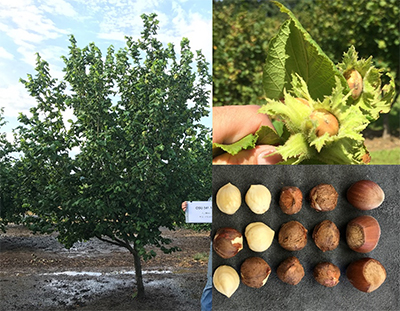
Figure 13: Hybrid Hazelnut Consortium cultivar ‘OSU 541.147’ The Beast™ hybrid hazelnut. Photo Credit Left and Bottom Right: Shawn Mehlenbacher Oregon State University. Photo Credit Top Right: Tom Molnar.
OSU 541.147 (The Beast™)
A cross of NY 616 (C. americana ‘Rush’ x C. avellana ‘Barcelona’) x C. avellana OSU 226.118, it is a high yielding hybrid hazelnut tree with small nuts and adequate blanching after roasting, making it suited for the kernel market (Figure 13). Most kernels are 9–11 mm in diameter with an average weight of 0.9 grams and 44% kernel by weight In New Jersey (kernels reported to be 1.1 grams in Oregon). ‘OSU 541.147’ is a vigorous, upright tree with a slightly spreading growth habit. It carries an EFB resistance gene from C. americana ‘Rush’ and has been shown to get no EFB in NJ or Oregon. ‘OSU 541.147’ is suggested for use primarily as a pollinizer in New Jersey, but growers may find that its consistent high yields of nuts outweigh its small kernel size. It has S-alleles 8 and 23 with S8 expressed in the pollen, and blooms in the early to mid-season in New Jersey making it a valuable pollinizer for the other Rutgers cultivars. It is compatible in both directions with ‘Monmouth’ (S1S12), ‘Raritan’ (S3S22), ‘Somerset’ (S3S10), ‘Hunterdon’ (S1S3), ‘Slate (NY616) (S1S23), ‘Gene’ (NY398) (S15S23), and ‘Grand Traverse (S11S25). Nuts typically drop from the second to third week in September. It is susceptible to bud mite in Oregon, but this has not been observed in New Jersey.
NY 398 ('Gene', 'Geneva')
A cross of C. americana ‘Rush’ x C. avellana ‘Red Lambert’ developed at the NY Agricultural Experiment Station in the early 1900s. It carries an EFB resistance gene from C. americana ‘Rush’ and has been shown to get no EFB in New Jersey and other eastern locations. NY 398 is a moderately vigorous tree that can produce good yields of medium size nuts with slightly oblong, pointed kernels around 0.85 grams in Rutgers trials (closer to 1.0 gram in Ontario [Taghavi et al., 2020]). It has thick shells (38–40% kernel by weight) with relatively poor blanching. Thus, NY 398 is suggested for use primarily as a pollinizer in New Jersey, although the nuts are suitable for the fresh, in-shell market. It has S-alleles 15 and 23 with S15 expressed in the pollen, blooms in mid-season, and has been shown to have cold hardy catkins in Ontario. NY 398 is compatible in both directions with ‘Monmouth’ (S1S12), ‘Raritan’ (S3 and S22), ‘Somerset’ (S3 and S10), ‘Hunterdon’ (S1S3), ‘OSU 541.147’ (S8 S23), ‘Slate’ (NY616) (S1S23), and ‘Grand Traverse’ (S11S25). It has shown significant bud mite susceptibility in Ontario and Oregon, but this has not been observed in New Jersey.
Grand Traverse
‘Grand Traverse’ originated from Michigan and is reported as a cross of ‘Faroka’ (F1 Turkish tree hazel [C. colurna] x European hazelnut hybrid) with the European hazelnut ‘Royal’ (Farris, 1989) (note that the S-alleles do not support ‘Royal’ being the pollen parent, but it appears to be European nonetheless). It is an upright, semi-vigorous tree with a slightly spreading growth habit. ‘Grand Traverse’ is a 25% Turkish tree hazel hybrid, which is evident in its corky bark and elongated “fingers” on its nut husks. It is believed to get its EFB resistance from ‘Faroka’. Kernels are compressed and slightly pointed, very free of fiber, and have an average weight of 1.3 grams and close to 50% kernel by weight In New Jersey. It has S-alleles 11 and 25 with both expressed in the pollen, and blooms in mid-season in New Jersey. It is compatible in both directions with all of the cultivars listed above. Note that past studies at Rutgers have shown it to be resistant to EFB in New Jersey and with the pathogen collected across multiple locations (Molnar et al., 2010a). However, in 2018 a few small cankers were observed on ‘Grand Traverse’ plants at Rutgers; thus, it should not be considered immune to the disease, but tolerant. This cultivar has performed well in tests in Lincoln, NE, but in New Jersey the late maturity of the nuts (drop last week of September) and low yields suggests its value is primarily as a pollinizer.
| Cultivar | Market Type | Notable Characteristics | S-alleles | Availability |
|---|---|---|---|---|
| Cultivars related to C. americana ‘Rush’ | ||||
| Slate (NY 616) |
In-shell | Corylus americana 'Rush' x C. avellana ‘Barcelona’. NY State Agricultural Experiment Station selection. Parent of ‘OSU 541.147’. Spreading habit, with medium to large slightly pointed nuts that drop from the husk at maturity (avg. 1.1 gram kernels, 40% kernel by weight in Ontario [Taghavi et al., 2020]; 1.4 gram kernels reported by L. Grimo). EFB resistant in New Jersey (‘Rush’ R-gene), bud mite susceptible in Ontario and Oregon. USDA Zone 6a-7b. | S1S23 | Grimo Nut Nursery; National Clonal Germplasm Repository (NCGR) |
| Cheryl (NY 110) |
In-shell | Corylus americana 'Rush' x C. avellana 'DuChilly'. NY State Agricultural Experiment Station selection. Medium to large sized oblong nuts (kernels 1.5 grams and 39% kernel by weight in Ontario [Grimo, personal communication]). EFB resistant (‘Rush’ R-gene), bud mite susceptible in Ontario and Oregon. USDA Zone 5a-7b. | S10S12 | Grimo Nut Nursery; NCGR |
| Linda (NY 104) |
In-shell | Corylus americana 'Rush' x C. avellana 'DuChilly'. NY State Agricultural Experiment Station selection. Large slightly pointed nuts (kernels 1.4 grams and 34% kernel by weight in Ontario [L. Grimo, personal communication]). EFB resistant (‘Rush’ R-gene), bud mite susceptible in Ontario and Oregon. USDA Zone 5a-7b. | S14S23 | Grimo Nut Nursery; NCGR |
| Carmela (Grimo 208P) |
In-shell | Offspring of NY 1329 ([C. americana 'Rush' x C. avellana ‘Cosford’] x open-pollinated). Selected by Grimo Nut Nursery in Niagara-on-the-Lake, Ontario. Large tree with oval nuts with kernels that are reported to have excellent flavor. Also reported as alternate bearing and late ripening. EFB resistant in New Jersey with 1.0 gram kernels and 32% kernel by weight. 1.4 gram kernels and 36% kernel in Ontario (L. Grimo Personal Communication). USDA Zone 5a-7b. | S23S25 | Grimo Nut Nursery |
| Cultivars related to C. colurna hybrid ‘Faroka’ | ||||
| Alex (Grimo 186M) |
In-shell | Offspring of C. colurna hybrid ‘Faroka’. Selected by E. Grimo (Grimo Nut Nursery in Niagara-on-the-Lake, Ontario). A moderately productive alternate bearing cultivar, nuts are oval and drop from the husk at maturity (avg. 1.1 gram kernels, 44% kernel by weight in Ontario [Taghavi et al., 2020]). EFB resistant in New Jersey trials. USDA Zone 5a-7b. | ND1 | Grimo Nut Nursery |
| Matt (Grimo 208D) |
In-shell | Offspring of C. colurna hybrid ‘Faroka’. Selected by E. Grimo. A moderately productive alternate bearing hazelnut. The nuts are reported to be larger than ‘Alex’ with no clinging fiber. (kernels 1.5 grams and 41% kernel by weight in Ontario [L. Grimo, personal communication]) EFB resistant in New Jersey trials. USDA Zone 5a-7b. | S11S13 | Grimo Nut Nursery |
| Cultivars of mixed hybrid origin (likely mix of ‘Rush’ and ‘Faroka’ origins) | ||||
| Chelsea | In-shell | Butternut Farms selection (M. Hodgson, Norfolk Co., Ontario). Originated from open pollinated seeds collected at Grimo Nut Nursery in 1992. Oblong nuts. Kernels 1.00 grams and 38% kernel by weight (Taghavi et al., 2020). Cold hardy catkins. EFB resistant. Chelsea nuts mature a week later than Norfolk (below). | S1S20 | Upper Canada Growers in Niagara-on-the Lake, Ontario; not yet available in US |
| Norfolk | In-shell | Butternut Farms selection (M. Hodgson, Norfolk Co., Ontario). Originated from open pollinated seeds collected at Grimo Nut Nursery in 1992. Oblong nuts. Kernels 1.34 grams and 42% kernel by weight (Taghavi et al., 2020). Noted for cold hardy catkins. EFB resistant. | S12S25 | Upper Canada Growers in Niagara-on-the Lake, Ontario; not yet available in US |
| Cultivars of Badgersett Nursery hybrids of mixed origin (C. americana x C. avellana x unknown) | ||||
| NITKA© | kernel | Selected by J. Zarnowski in Cortland, NY of Badgersett (MN) seedling origin. Medium size round nut around 1.1 grams and 52–55% kernel by weight. Upright growth habit, resistant to EFB, cold hardy catkins. Ripens last week of August to first week September. USDA Zone 4b–7b. | S5S17 | Z’s Nutty Ridge LLC |
| Photon | kernel | Selected by J. Zarnowski in Cortland, NY, of Badgersett (MN) seedling origin. Medium size round nut around 1.1 grams and 44–48% kernel by weight. Upright growth, resistant to EFB, cold hardy catkins. Ripens second to third week of September. USDA Zone 4b–7b. | ND | Z’s Nutty Ridge LLC |
| Upper Midwest Hazelnut Development Initiative Selections (UMHDI) | kernel | 12 improved selections identified from thousands of seedlings distributed across MN and WI of Badgersett and Forest Agriculture Nursery origins. They are in clonal replicated trials at the University of Wisconsin and University of Minnesota (see Upper Midwest Hazelnut Development Initiative and Hazelnuts 101 A Fact-Sheet Series for Beginning Hazelnut Growers in the Upper Midwest for more info) and are being propagated for on-farm testing throughout the region. The plants were selected for cold tolerance, high kernel yield potential, and EFB resistance. USDA Zones 3–4. | ND | TBD UMHDI (expected in spring 2021) |
| Cultivars related to Saskatchewan C. americana origins (Morden Experiment Station in Manitoba, Canada) | ||||
| Kiara | kernel | Seedling of an unnamed hybrid hazelnut originating at the Morden Experiment Station in Manitoba, Canada, selected by E. Grimo. The parent tree is reported to be a wild Saskatchewan C. americana that was crossed with pollen shared from George Slate at the Geneva Experiment Station in NY (1960s). EFB resistant. Kernels are reported to be 0.6 grams and 37% kernel by weight. | S14S23 | Grimo Nut Nursery |
| Frank | kernel | Open pollinated seedling selected from the same source as ‘Kiara’ above by E. Grimo. Kernels are reported to be 1.1 grams and 40% kernel by weight with late season pollen shed. Only one S-allele has been determined. EFB resistant. | S14S? | Grimo Nut Nursery |
| Marion | kernel and in-shell | Open pollinated seedling selected from the same source as ‘Kiara’ by E. Grimo. Kernels are reported to be 1.2 grams and 37% kernel by weight with late season pollen shed. EFB resistant. | S14S25 | Grimo Nut Nursery |
| Joanne | kernel | Open pollinated seedling from the same seed source as ‘Kiara’ by E. Grimo. Nut data was not available, but it is reported to be a late season pollenizer. Report of EFB in Wisconsin but not in Ontario. | S2S14 | Grimo Nut Nursery |
| Cultivars related to ‘Skinner’ C. americana | ||||
| Dermis | kernel | Open-pollinated seedling of ‘Skinner’ (a Hudson Bay wild C. americana selection x C. avellana ‘Italian Red’) selected by E. Grimo. Kernels are reported to be 1.0 grams and 38% kernel by weight with mid to late season pollen shed. EFB resistant. Note that ‘Skinner’ was shown to get EFB in trials at Rutgers (Capik and Molnar, 2012). | S12S16 | Grimo Nut Nursery |
| Cultivars with C. heterophylla origin | ||||
| Aldara | kernel | Open-pollinated seedling selected from a C. heterophylla hybrid source originating in Quebec by E. Grimo. Kernels are reported to be 1.0 grams and 43% kernel by weight with mid to late season pollen shed. EFB resistant. | S25S27 | Grimo Nut Nursery |
| Andrew | kernel | Open-pollinated seedling selected from same source as ‘Aldara’ by E. Grimo. Kernels are reported to be 1.12 grams and 31% kernel by weight with mid-season pollen shed. EFB resistant. | ND | Grimo Nut Nursery |
| Northern Blais | kernel | Open-pollinated seedling selected from a C. heterophylla hybrid source originating at Grimo Nut Nursery and selected in Quebec by Jacques Blais from Joly, QC. Kernels reported to be 1.0 gram and 35% kernel by weight. EFB resistant. | S8S25 | Grimo Nut Nursery |
1S-allele not yet determined (ND)
A Note on Eastern Filbert Blight Management
The pathogen that causes EFB is genetically diverse in the eastern U.S., unlike in Oregon where it is uniform and was likely a single point introduction (Tobia et al., 2017; Muehlbauer et al., 2019). Disease management strategies must take this into consideration. Horizontal resistance, also called quantitative resistance, concentrates multiple genes for high tolerance, which reduces the chance that the fungus can overcome the resistance over time. Tolerance is not immunity; under high disease pressure, trees can develop small cankers, but they have little to no impact on production and frequently do not even reproduce (no spread of spores). Vertical resistance relies on a single gene that provides complete protection from infection. It can be very effective, but overuse (think monoculture) can lead to fungal evolution to overcome resistance. Combining plants with both mechanisms for disease protection (horizontal and vertical) in the orchard is expected to support long term disease management without the use of protective fungicide sprays. It is strongly recommended that this approach be followed in New Jersey and other parts of the Mid-Atlantic region.
‘Raritan’, ‘Monmouth’, and ‘Hunterdon’ are protected by horizontal resistance. ‘Somerset’ is protected by vertical resistance via a single gene from ‘Ratoli.’ ‘OSU 541.147’ the Beast™, ‘Gene,’ and ‘Slate’ are protected by a different single gene from the wild American hazelnut ‘Rush.’ The 'Ratoli' and 'Rush' sources of vertical resistance continue to hold up very well in the eastern U.S. (Molnar et al., 2010a; Molnar, unpublished). The Oregon State University cultivars (‘Jefferson,’ ‘Yamhill,’ ‘Dorris,’ etc.) are protected by a single gene from ‘Gasaway,’ which is on a different chromosome than the ‘Ratoli’ and ‘Rush’ gene. Unfortunately, although this gene works well in Oregon, it does not hold up in New Jersey and other eastern locations. Hybrid hazelnut seedlings are genetically variable (some may get EFB) and can carry horizontal and/or vertical forms of resistance, depending on the source.
Planting disease-free trees from reputable sources is a critical piece of EFB management. EFB only comes from infected hazelnut trees. The fungus can only infect and live on hazelnut stems (not in soil, plant debris, etc., and not in the roots of a hazelnut plant), and spores that spread the fungus only come from cankers on infected hazelnut plants. If you have no EFB in your area (no known infected hazelnut trees) and plant only EFB-free planting stock, then you significantly reduce the chances you will ever see it in your orchard. Planting resistant and highly tolerant plant material that comes free of disease from a reputable nursery will give you the best foundation for long term disease management. You should also learn to identify EFB and scout for cankers in the winter after the leaves have dropped (Figure 1). If you see any cankers, prune them out 2–3 feet below the canker, then burn or chip the infected stems (in small backyard gardens, bag the branches and throw out in trash). The disease spreads in the spring and summer during rainy periods, so winter pruning can drastically reduce disease pressure in the orchard. With that said, it is suggested to prune out EFB cankers any time you see them!
Sources of Hazelnut Trees
Listed below are a number of nurseries that sell hazelnut trees. This list is not all inclusive and does not imply Rutgers University endorsement of these nurseries. Nurseries not included on this list are not inferior. If any nursery selling hazelnut trees has been omitted, we would appreciate receiving an e-mail or catalog to ensure we include it in future bulletin updates.
Foggy Bottom Tree Farm (Columbus, NJ). Inventory includes European hazelnut cultivars Raritan, Monmouth, Hunterdon, and Somerset released by Rutgers University and OSU 541.147 The Beast™ hazelnut released from the Hybrid Hazelnut Consortium. Seedling pollinizer trees also available from select origins including hybrid hazelnuts. For retail mail order sales see https://www.foggybottom.farm/home.
Grimo Nut Nursery (Niagara-on-the-Lake, Ontario, Canada). Inventory includes clonal cultivars and hybrid selections from the New York Agricultural Experiment Station as well as selections from their own breeding efforts (see Table 2). Seedlings also available.
Z’s Nutty Ridge (McGraw, NY). Inventory includes cold hardy EFB-resistant hazelnut seedlings from selected parents and two clones in propagation (NITKA© and Photon) from their own selection efforts.
Great Plains Nursery (Weston, NE). Inventory includes Turkish tree hazel hybrid ‘Grand Traverse’ and ‘OSU 541.147’ The Beast™ hazelnut as well as hybrid hazelnut seedlings of mixed origins.
Upper Midwest Hazelnut Development Initiative. An extensive listing of nurseries selling hazelnuts for growers in the Upper Midwest.
Forest Agriculture Nursery (Viola, WI). Inventory includes cold hardy, EFB resistant hybrid hazelnut seedlings from select hybrid parents.
North American Plants, Inc. (Lafayette, OR). Micropropagation lab whose inventory includes clonal C. avellana cultivars, most of which are from the Oregon State University breeding program.
Nut Growers Society Oregon, Washington, and British Columbia. The website includes a list of nurseries (with contact information) propagating hazelnut cultivars, most of which are in Oregon.
References
Mention or display of a trademark, proprietary product, or firm in text or figures does not constitute an endorsement by Rutgers Cooperative Extension and does not imply approval to the exclusion of other suitable products or firms.
May 2021
Copyright © 2025 Rutgers, The State University of New Jersey. All rights reserved.
For more information: njaes.rutgers.edu.
Cooperating Agencies: Rutgers, The State University of New Jersey, U.S. Department of Agriculture, and Boards of County Commissioners. Rutgers Cooperative Extension, a unit of the Rutgers New Jersey Agricultural Experiment Station, is an equal opportunity program provider and employer.

